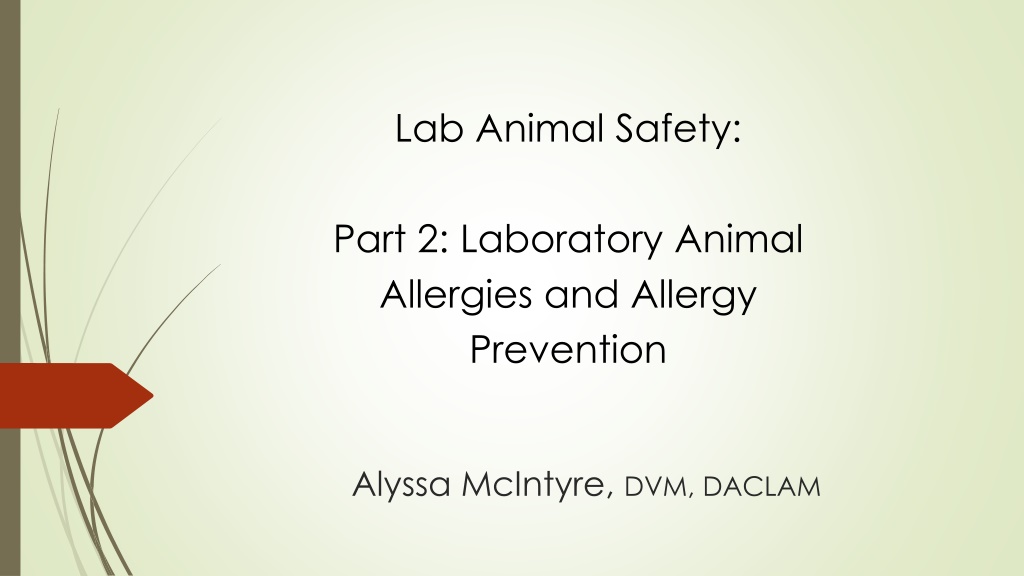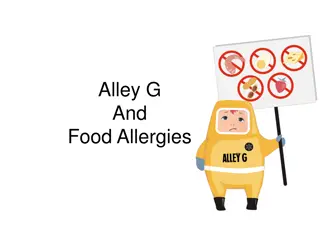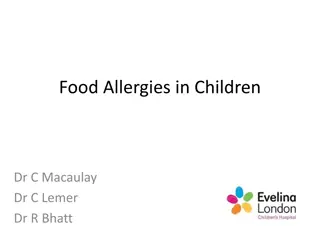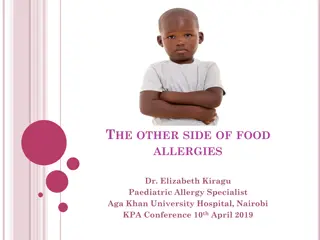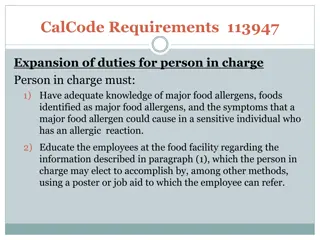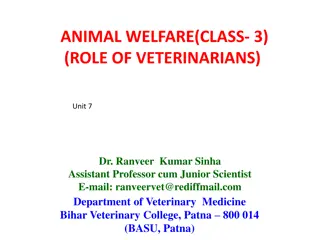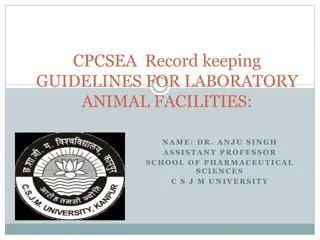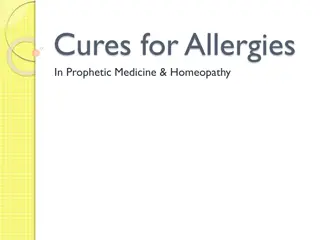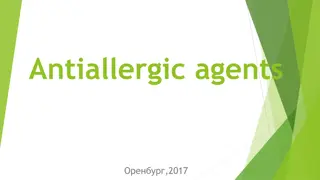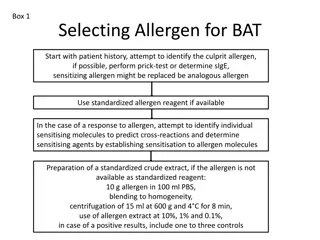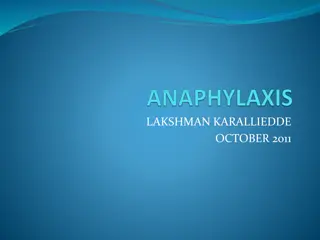Understanding Laboratory Animal Allergies and Prevention
Laboratory animal allergies pose a significant occupational hazard, with around 2 million workers at risk. Exposure routes include inhalation, skin contact, and ingestion. Factors such as pre-existing allergies, intensity of exposure, and secondhand exposure influence the likelihood of developing allergies. Animal allergens like endotoxin, pet dander, and urine can trigger allergic reactions, even in low concentrations not visible to the naked eye. Rodent facilities have specific allergens like urinary proteins and salivary proteins. Prevention strategies and awareness of allergen sources are crucial in managing laboratory animal allergies.
Download Presentation

Please find below an Image/Link to download the presentation.
The content on the website is provided AS IS for your information and personal use only. It may not be sold, licensed, or shared on other websites without obtaining consent from the author. Download presentation by click this link. If you encounter any issues during the download, it is possible that the publisher has removed the file from their server.
E N D
Presentation Transcript
Lab Animal Safety: Part 2: Laboratory Animal Allergies and Allergy Prevention Alyssa McIntyre, DVM, DACLAM
Laboratory Animal Allergies Objectives: Are you likely to become allergic to lab animals? Allergens and exposure Health Issues caused by Animal Allergens Causes and Prevention
Lab Animal Allergies (LAA) Significant occupational hazard! Approximately 2 million workers have jobs that require contact with animals or animal products Multiple sources estimated prevalence of animal allergies in workers range from 5% to 40%
Routes of Exposure to Allergens Inhalation of airborne allergens Most common form of exposure Skin contact Eye contact Ingestion Via inhalation
Risk Factors If you have pre-existing allergic disease, your risk of allergic reactions to lab animals is up to 73% Existing Allergy to pets or other species Allergies to other things, including hay fever, allergic skin rashes, allergic asthma, food allergies Atopy Intensity / duration of animal allergen exposure Airborne contamination Skin/eye contact Secondhand from co-workers Brought home on clothing
Animal Allergens Endotoxin Pet Serum Dander Allergens Urine and Saliva Fur What about the non-animal allergens? Scales
But the room doesnt smell bad, and I cant see dust Respiratory exposure? Nanogram concentrations can elicit symptoms (ppb)
Major Animal Allergens in Rodent Facilities Rat Rat n 1 urinary protein Salivary proteins Mouse Mus m 1 urinary protein Higher levels in male mouse urine than female
Human exposure to allergens is directly related to the normal activities of an animal: #1: Urinary Proteins In this picture, what are the potential allergens? AND Dander/hair contaminated with saliva Bedding Food dust
Types of Allergens common in Animal Facilities Animal Proteins (allergens) Allergic reactions may also be triggered by: Urine Saliva Dander (flakes of skin) Latex Chemicals including Chlorhexidine and Iodine Food/ food dust Bedding dust
Medical Surveillance Programs Identify workers with or at higher risk for LAA Identify new cases of LAA or allergies to new species Yearly assessment typical Employees can report new symptoms anytime during the year
Allergic Reactions Hypersensitivity Reactions Definition: excessive, undesirable (damaging, discomfort-producing and sometimes fatal) reactions produced by the normal immune system Require a pre-sensitized host Can be divided into four types based on mechanisms involved and reaction time Immediate Phase Reaction: Type I Late Phase Reaction: Type II, III and IV
Health issues: Hypersensitivity Reaction Overview Immediate Reaction Type I 15-20 minutes Called atopic allergy Examples: asthma, hay fever, hives Most common type of animal-associated allergy
Type I or Immediate Hypersensitivity Symptoms: Itching Sneezing Watery discharge Congestion Conjunctivitis Asthma Urticaria Anaphylaxis
Anaphylaxis: Emergency Skin itching, hives, redness, swelling Nose sneezing, stuffy nose, runny nose Mouth itching, swelling of lips or tongue Throat itching, tightness, difficulty swallowing, swelling of the back of the throat Chest shortness of breath, cough, wheeze, chest pain, tightness Heart weak pulse, passing out, shock Gastrointestinal (GI) tract vomiting, diarrhea, cramps Nervous system dizziness or fainting Although unlikely, this most commonly occurs after being bitten by a rodent - Call 4-4444
Type II, III, or VI Hypersensitivity Late Reaction Type II Minutes to hours Type III: 3-8 hours Type IV: 48-72 hours T-cell mediated Symptoms: Contact dermatitis (like poison ivy) Skin erythema (redness) Anemia Less commonly associated with LAA
Allergy Onset Statistics Most people who will develop LAA will do so within the first 3 years of employment. Those people that become allergic: ~ 1/3 will become symptomatic within the first year, 70% within the next 3 years ~ 30% who develop allergies will develop asthma ~ 70% who will develop asthma associated with LAA will do so within 3 years of developing the initial allergy People who already have allergies are more likely to develop LAA
Lab Animal Allergy and Asthma Onset Statistics: Example population In 2015, 100 people begin working in an animal facility where the prevalence of lab animal allergy will be 30% (30 people) 10 people develop allergies in 2015; 20 develop allergies between 2016-2017 Of those 30 people, 10 develop asthma during their lifetime; 7 people will develop asthma between 2016- 2020
Allergy summary: What does this mean for me? If you already have animal allergies, you are at high risk for developing allergies to lab animals Lab Animal Allergy is most often manifested by nasal symptoms (allergic rhinitis), itchy eyes (allergic conjunctivitis), and rashes (contact urticaria, atopy) Allergy symptoms usually evolve over a period of 1-3 years and may lead to acute anaphylaxis in a small number of patients Lab Animal Allergy can lead to asthma (which can be a permanent medical condition)
Prevention and Treatment of Lab Animal Allergies Early intervention Tell your doctor or Health services as soon as you notice symptoms Follow treatment recommendations Appropriate precaution Wear PPE at work Don t take allergens home on street clothes Avoid allergens- home or workplace Allergy prevention is better than any allergy treatment!
NIOSH Recommendations Avoid wearing street clothes while working Leave work clothes at the workplace to avoid exposing family members / roommates Keep all cages and work areas clean!
NIOSH Recommendations Preventative measures: Animal handlers should take steps to protect themselves from exposure to animals and animal products Reduce skin contact and inhalation by wearing PPE Perform animal manipulations within ventilated hoods when possible HEPA ventilated cages are recommended when feasible (~ 50 filter top cages are available at UNCG, HEPA ventilated cages are not available)
PPE Lab Coat Dedicated to facility, leave it there! Shoe covers Don t track allergens out of the facility! Gloves Nitrile or latex latex allergy common N-95 respirators For those with allergies Medical screening prior to use Annual Fit test
Work Practices and Prevention Dedicated lab coats and disposable PPE are provided to minimize contact with allergens Education and training programs Hoods available for procedures Personal Protective Equipment WEAR YOUR PPE !!!
Allergen containment within the facility Air pressure in animal rooms is maintained negative relative to the corridor only when the door is closed When the doors are held open for more than a few seconds, airflow equalizes and air (and airborne allergens) backflow into the corridor Keep doors in the facility closed Don t wear your PPE outside the facility!
If you might be allergic to our animals Notify your supervisor or PI Notify Occupational Health medical staff Consult with the Environmental Health and Safety office to schedule fit testing and respirator training
Questions? Please direct questions to: Environmental Health and Safety office Facility Veterinarian Occupational health doctor at health services
References ALLERGENS." Occupational Health and Safety in the Care and Use of Research Animals . Washington, DC: The National Academies Press, 1997 Laboratory Animal Allergy: An Update. ILAR J (2003) 44 (1): 28- 51 Hypersensitivity. Microbiology. Berkeley College. Beatty, Robert. <http://mcb.berkeley.edu/courses/mcb150/Lecture20/Lecture 20(6).pdf> Laboratory Animal Allergy. J Allergy Clin Immunol 1998;102:99- 112. Prevention of laboratory animal allergy. Occup Med 2003;53:371 377
References Laboratory Animal Allergies. Lowrie, Jonathan, and Reid Boswell. SoCal Tri Branch Symposium. University of California, LA National Institute of Occupational Safety and Health. <http://cdc.gov/niosh > Exposure of laboratory animal care workers to airborne mouse and rat allergens. J Am Assoc Lab Anim Sci. 2012;51(5):554-60 Laboratory Animal Allergens. ILAR J (2001) 42 (1): 12-16. BioReliance <http://www.bioreliance.com> CDC-Centers for Disease Control and Prevention. <http://www.cdc.gov>
